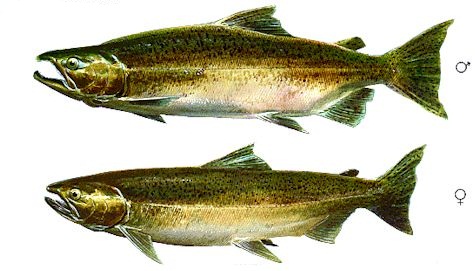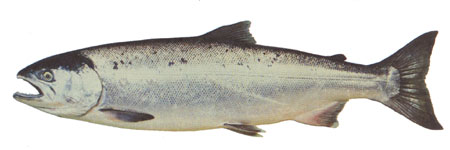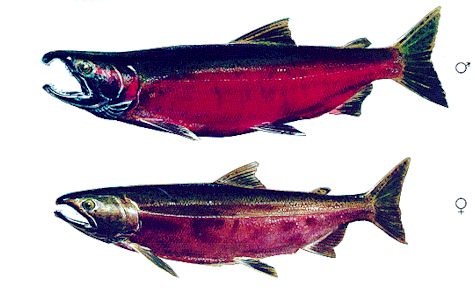Salmon & Halibut Information
Pacific Rim Fishing Charters – Salmon & Halibut Information
CHINOOK SALMON
(ALSO KNOWN AS SPRING, TYEE AND KING) – ONCORHYNCHUS TSHAWYTSCHA
How Can You Tell the Difference?
Anglers should use three or more distinguishing characteristics to properly identify all salmon. In the juvenile stage of chinook salmon, some fishers misidentify them as pinks because both have spots on their tails.
DESCRIPTION OF CHINOOK SALMON IN MARINE PHASE
Black gums and a silver, spotted tail distinguish the chinook from other salmonids. It has a lightly spotted blue-green back and is the largest, most prized game fish. The chinook lives from three to seven years. It weighs between 1.5 kg and 30 kg. Average-size chinooks are often known as springs in B.C. Those over 13.5 kg are called tyees,
and in the U.S., chinook are called king salmon.

DESCRIPTION OF CHINOOK SALMON IN FRESHWATER PHASE
Fresh run fish are very similar in appearance to salt water fish – lightly spotted blue-green back, black gums and a silver, spotted tail. As chinook mature, they become very dark in colour – some dark reddish, and others almost black.

Chinook Jaw The chinook has black gums at the base of its teeth and its mouth is dark. In some areas it is known as “black mouth”. |
Chinook Tail The chinook has a flowing V-shaped, silvery tail that is generally covered with spots. The tail becomes more square as the chinook reaches adult stage. The chinook has a flowing V-shaped, silvery tail that is generally covered with spots. The tail becomes more square as the chinook reaches adult stage. |
Coho Salmon (also known as blueback and silver) – Oncorhynchus kisutch
How Can You Tell the Difference?
Anglers should use three or more distinguishing characteristics to properly identify all salmon. Coho are sometimes confused with chum because they both have similar colouring. Always look for the coho’s white gums and a few spots on the tail.
Description of coho salmon in marine phase
Coho have white gums, black tongues and a few spots on the upper portion of their bodies and silver-coloured tails. They have a wide tail base. Bright silver with a metallic blue dorsal surface. Coho usually live for three years and grow rapidly in their final year. They weigh between 1.3 kg and 14 kg. In the Strait of Georgia from April to early June, small coho passing from the grilse stage to maturity are called bluebacks.

Description of coho salmon in freshwater phase
Fresh run coho are very similar in appearance to salt water fish – bright silver with a metallic blue dorsal surface, and a wide tail base with a few spots on the upper portion of their silver-coloured tails. As coho mature, the males become reddish on the sides, and green on the back and head, often dark on belly. Females are less strongly coloured.

Coho Jaw The coho’s gums at the base of the teeth in the lower jaw are almost white. Its mouth is white but can have a black edge. It has a black tongue and it has sharp, strong teeth. |
Coho Tail The coho has a square, silver – coloured tail with The coho has a square, silver – coloured tail withjust a few scattered spots, usually on the upper portion of the tail. It has a wide tail base. |
With a fantastic seasonal Sport fishing forecast released earlier this year, it is very welcome news to Ucluelet area anglers that good things can become even better, and in the case of Salmon numbers and related fishing opportunities, much better. Since compiling the 2013 Seasonal Outlook early in the New Year, I have monitored the forecasts for Salmon returns to many of the primary Watersheds on B.C.’s South Coast, with highlighted attention paid to the abundant southern migrating stocks to U.S. Rivers in Washington, Oregon and California. Alike the Canadian Fisheries process, preliminary data is released in the U.S. with “cautious” return forecast numbers being made public using an autoregressive model. As more data becomes available with in-season catch, or different modeling processes are applied, the Salmon numbers can change. Considering that the abundant and diverse Salmon stocks of the U.S. Pacific Northwest augment Tofino and Ucluelet Sport fishing opportunities by approximately 85% of the catch, this is where things have become really interesting over the last couple months.
For Oregon’s Klamath River, biologists are forecasting four times more salmon than last year – and an astounding 15 times more than in 2006. The ocean salmon population is estimated to be 1.6 million adult Klamath River fall Chinook, compared to last year’s forecast of 371,100. This estimate is based largely on the 85,840 two-year-old salmon (jacks) that returned to the Klamath in 2011. This is the highest number of jacks to return since at least 1978, when recordkeeping began. A little further north, Washington State and Columbia River Chinook and Coho will also contribute well over 1 Million Salmon to the mix.
California’s Sacramento stocks are also looking better; with a conservative forecast of ocean abundance of 819,400 Sacramento River fall Chinook, up from 729,000 last year. Sacramento fall Chinook are known to be a genetically “robust” species, so combining the average size and strength of these Salmon with prime Ocean survival conditions should equate to over three quarters of a Million healthy Sacramento Chinook salmon feeding along southern Vancouver Island this spring and early summer. With nearly 2.5 Million Chinook Salmon for these two rivers alone, and numbers compounded by over one hundred other runs that feed and travel past Tofino, the Salmon forecast has become much brighter.
Some other positive aspects to the local Salmon Fishery for 2012 are related to returning 5 year old Chinook salmon to Robertson Creek hatchery in Port Alberni. While Chinook returns to RCH in 2011 were higher than forecasted, the anticipated 4 year old component of the run size was not there. It is speculated that due to high quality ocean conditions, this portion of the run stayed at sea, and could very likely return as larger 5 year old Chinook in 2012. Coho Salmon numbers are also anticipated to be good to strong for many systems again this season, which has contributed to the consideration by DFO to potentially remove an inner boundary line which has been deemed redundant to management of stocks and enforcement. This potential change would truly enhance Tofino’s inshore and near-shore Coho Salmon fishing opportunities for the many local anglers who cherish the great summer action with lighter tackle, within a safe proximity to Tofino’s harbour.
The recreational Halibut Fishing season in B.C. has received attention and change by DFO since the New Year, with changes to the overall allocation of Halibut within Canada to a split of 85% Commercial and 15% Recreational. These changes alter the management of the allowable catch for the user groups, as well as new size and possession limits for sport fishing on the B.C. coast. With 2013 being a year of low abundance of the “Exploitable Biomass” of Pacific Halibut, the amount of Canada’s harvestable Halibut has further decreased from 2011, which saw an in-season closure by the first week of September. In efforts to allow for a full season for sport anglers, new regulations will allow a catch limit of 1 Halibut per day of any size, with a possession limit of 2 for anglers fishing more than one day away from their primary residence. One of the Halibut in possession will have a maximum size limit of approximately 15 pounds, which will help reduce and “stretch” the seasonal catch poundage out through the main summer fishing season. With a strong overall biomass of Pacific Halibut, it is anticipated that B.C. Halibut fishing will cycle back to “normal” regulations and allowable catch limits within a couple years.
With the enhancement of the Salmon Fishing forecast, and the current stability of Halibut fishing opportunities, Tofino and Ucluelet’s fundraising fishing derbies have an excellent landscape for success. Numerous grassroots fundraising initiatives have been success stories along the BC coast, most of which help Salmon Enhancement and Habitat by leveraging funds and co-operative efforts of groups large and small. Everything from Derby’s to individual donations compound positive for Salmon. Some people are still of the mind-set that it is the responsibility of the Federal Government to foot the bill for all of these types of programs. We will be waiting a long time for that to happen as budgets are slashed and manpower is reduced, so stakeholder involvement is crucial to say the least. Tofino and Ucluelet Salmon Enhancement sees benefit from three main Fishing Derbies during the summer months, as well as other smaller aspects of fundraising and donations. We encourage you to consider involvement in either or all of the following; Tofino Saltwater Classic Derby, Tofino Legion Derby or the Ucluelet Salmon ladder Derby. Fun, Fishing and Fundraising, a great combination to be involved with.
With great numbers of Chinook salmon already present in the Ucluelet area, and spring-like conditions looking even better on the horizon, 2013 looks to be a season that will provide many great Fishing opportunities for most species. Fishing Charter and Package options are still available for a number of shoulder and high season dates for groups large and small, and Pacific Rim Fishing Charters & Guest Lodge are always eager to help with all options.

